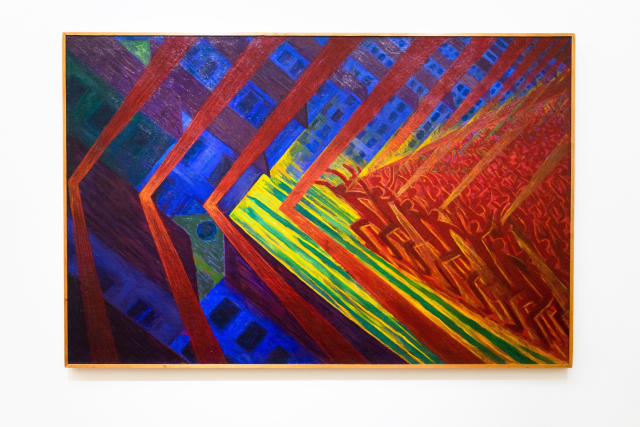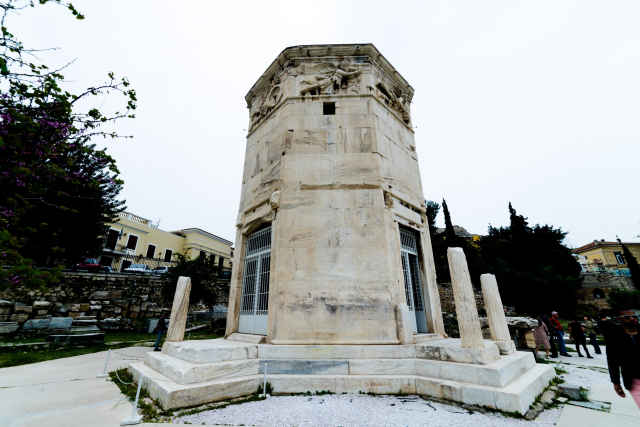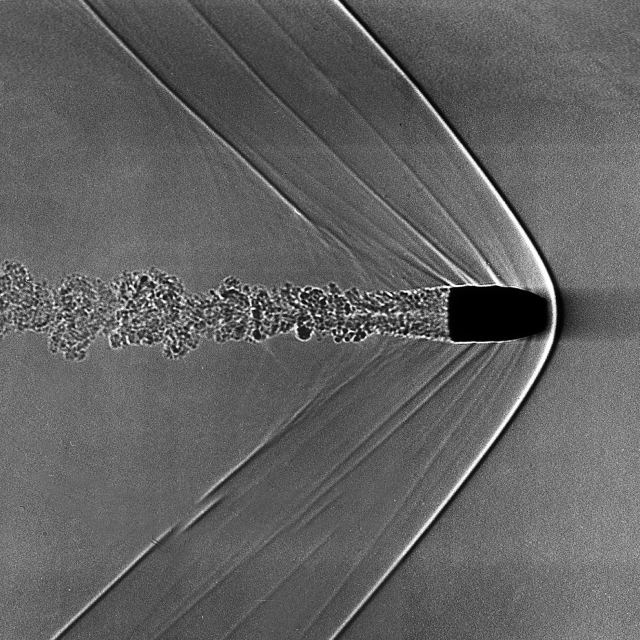Haseeb Ahmed on Luigi Russolo Futurista
We sat with research-oriented artist Haseeb Ahmed to talk about Luigi Russolo’s The Revolt, a painting that bears formal and conceptual similarities with his practice.

The Revolt, Luigi Russolo, 1911, photographed by Haseeb Ahmed at the State Museum of the Hague, 2019.
—
The work of Brussels based artist and PhD Haseeb Ahmed cannot be understood and appreciated without a notion of so-called artistic research. Alike an academic in any other university field, he has delved deeply into a rather specific research topic, that is the connection between visual art and the branch of physics called fluid dynamics. Despite of how conceptual and idiosyncratic this work might sound, a layperson has also a lot to take from it, as Ahmed’s artworks are formally striking. His installations, sculptures and drawings make use of material from fluid dynamics research, including flow visualisations, wind tunnel architectures, and even historical motifs somewhat linked to the theme at hand. All these elements allow him to produce works that are visually compelling and rich in content at once. For this At the Show with the Artist we asked some questions about Luigi Russolo’s painting The Revolt, discovering that this picture shares much more than its shapes with Ahmed’s artwork.
Both your work and Russolo’s The Revolt are visual representations of something that cannot be seen. In your case, it is the physical phenomenon of the wind, in Russolo’s it is the abstract concept of the social revolt. If for Russolo a visual representation of a social phenomenon was necessary for political purposes, what is the necessity that drove you to represent the wind? In other words, why do you think it is necessary to experience the wind visually and not just haptically as we are used to?
I believe that Russolo and I are both using the fluid phenomena to give form to that which does not yet have one. All life is contained within the relatively thin layer of fluid air of the atmosphere surrounding the Earth. All that occurs as movement leaves turbulent formations in its wake. This includes social revolution as in Russolo’s painting. While I feel we share this common understanding, my work, taking place over 100 years later, differs insofar as I do not have a clear object.
And yet, this idea of giving form to the invisible keeps recurring in history.
The relationship between time and fluid movement is very well documented. The ancient Greek Heraclitus stated that “one can never step into the same river twice, for you are not the same person nor is it the same river.” Change is the only constant. However, the Greeks also believed, as many cultures do, in the vital fluid principle of Pneuma that coursed through our beings. Counterintuitive as it may seem, to recognise this mutable reality of fluid is to recognize a shared internal and external truth. In Genesis it is this vital breath as the Hebrew “Ruach” that has brought reality into existence even before the existence of light.

Detail of water tunnel flow visualization in the Wind Egg exhibition at the Museum of Contemporary Art of Antwerp (MuHKA) by Haseeb Ahmed.
This understanding of fluid movement as in Heraclitus and as wind therefore furnishes an entire conception of time. In her book Pneuma and the Visual arts in the Middle Ages and early Modernity (2016) Barbara Baert eloquently suggests “a circular movement of created and creating time. This wind time connects with the conviction that life is capricious, changeable, unpredictable, but that this is uncontrollability also contains beauty: the knowledge that nothing passes away. The acceptance of cosmic time means the prevailing of an experience of time that unwinds to its endpoint like a ball of wool. This makes way for a second wind time that indicates that fate of humanity in cosmic space, isolates it, defines it and makes it graspable. This is the distinctive breeze of swift Kairos of the streaming forelock.”
How does this cosmic dimension connect to the rather clear political agenda of Russolo’s painting? The concept of wind time Baert talks about seems rather detached from it, and yet you bring it up in this context.
This notion of time is modelled on and analogous to the vortex movement of fluid itself. Hegel’s notion of time as a spiral or Aufheben shares this form of conception. Marx mobilized this concept by clarifying the task of the present given to it by the past, which is to recognise the repetition of social phenomenon occurring over time. Instead of experiencing this like the weather in an alienated form, he proposed the possibility of anticipating and acting ahead of its occurrence in time. In 20th century politics we know this as the Vanguard party and in art it takes the form of Avant-garde movements like that of Italian Futurists to which Russolo belonged. The avant-garde tendency in Russolo’s work is as undeniable as the forward movement in the painting’s composition. The object of movement is composed of revolutionary human bodies moving in sync in time. The still and static fluid medium being displaced melds with buildings which represent the incumbent vestiges of the past. This painting represents revolution as it is titled.
As revolutionary as Italian Futurism might seem, that avant-garde movement has been criticized for its conservative—typically fascistic nationalist—politics. How can we disregard this problematic aspect of Futurism and focus on the formal quality of artworks that came out of that experience?
Philosopher Boris Groys employs fluid movement for his apologia for the Futurists in his book In the Flow when he states that “the goal of the radical avant-garde is to tell the truth about the material world by making the artwork share the fate of all the other things of this world. That is why the radical avant-garde wanted to destroy museums and other traditional art institutions that protected artworks from their immersion and possible dissolution in the material flow. The artwork had to be put at risk and confronts with the same force of destruction that endangered ordinary things. The avant-garde is traditionally accused of being elitist, which is very ironic. The radical avant-garde wanted to be universal, to share the common fate of things.” Perhaps this too maintains a place for the biblical flood regularly decimates the world.
So destruction of artworks indirectly serves this purpose of political revolution, which sounds really outdated in the context of an art practice of 2019. Perhaps what could be saved from it now is really this metaphor of fluidity, which is also crucial to your own work. What is your take on the issue of what needs to be abandoned and what needs to be saved from Russolo’s context?
Albeit differently for both, revolution may have appeared as an inevitability for Marx and Russolo at the turn of the 20th century. Working 100 years later, I know that we must abandon the inevitability of revolution as the object of history. It is the inevitability not the necessity of revolutionary politics that must be abandoned. If we translate this to the semiotics of visual art it may be akin to abandoning the object of representation. The avant-garde’s seemed to believe that if revolution could be given an adequate visual form the revolution would come into being— both as products of shared political consciousness. We now know that this is not the case and it may mean that representation itself is antiquated. It is not entirely obsolete because that would imply we have shifted to an entirely new social register. Our era is still characterised by capitalism and so we are left only with weakened devices and consciousnesses to address it. Technology will not furnish these new capacities, only those that we can already imagine.
Contemporary technology is the other core of your work. You handle it, you criticise it, you engineer your own to make art. This seems a radically different approach compared to Russolo’s, who after all used the antiquated technology of oil on canvas for his painting.
Insofar as the present reproduces the past, I insist that Russolo and I have similar ambitions in making art and are drawn to fluid phenomenon for the same reasons. However, I believe that some art must now be made with the tools and technologies that shape our industrially produced realities beyond traditional artistic media that merely depict it. The futurists were drawn to the acceleration of technology as a rhetoric but I feel I must now actually employ it. I work with technology not to positivistically explore its unrealised potential like a start-up, rather my interest is in calling into question the social expectations we have on technology to “save us” especially when, as dead labor, it can only reproduce existent paradigms. My aim in representation is to “Bracket Out” our present moment which exists devoid of the motive force that enabled the vanguard and avant-garde movements of the 20th century.
Can you give us some examples of this approach from your exhibitions?
My recently completed trilogy The Wind Egg contains many instances of this “bracketing,” insofar as I bind together two extremely distant elements through my work. For instance, The Wind Egg attempts to realise the ancient concept that animals and people can reproduce with the wind the way plants do. A famous example of this in Western European imagination is the Virgin Mary’s immaculate conception. I attempted to realise this possibility using cutting edge wind tunnels at the NATO von-Karman Institute for Fluid Dynamics near Brussels. I created three different experimental facilities that could be visited as artistic installations, which contained many historical reproductions, for example a reconstruction of the ancient Greek building of the Tower of the Winds, now made to hold a wind tunnel.

Tower of Winds and Vulture at The Wind Egg exhibition at MuHKA, Haseeb Ahmed 2018.

Tower of the Winds, Athens Greece, photographed by Haseeb Ahmed.
I began the experiment with animal trials before moving to human ones. Vultures were commonly thought to reproduce solely with the wind and to be exclusively female. I chose to work with them for this new form of conception as they are commonly associated with death. Here we have mythology bound to science, sexuality bound to technology, birth bound to death. By creating these relationships, I offer a frame of reference through which we can triangulate our location in spacetime. I ask, how can we calibrate ourselves in our own present? My work is a contribution to this effort, in the hope of recovering the possibility to act ahead of the inevitable reputations of socially constructed time.
Coming back to technology, the technical imagery that inspired Russolo’s work also seems to do so for yours.
Russolo and I both use the scientific measurement techniques of wind tunnel flow visualisation. Russolo and many of the futurists were inspired by images of supersonic wind tunnel tests created by Ernst Mach. The painting is directly modelled on a shockwave that occurs when an object breaks the sound barrier, or when that state is simulated in a wind tunnel. The painting bares especially close resemblance to the Schlieren visualisation, also called shadowgraphy. In this instance, enough air is aggregated in the shockwave lines that it becomes denser than the one around it. When light is projected onto the wind tunnel test section, this shockwave can be photographed because of the shadow cast by the denser areas.

“Supersonic Bullet Shadowgraph”, image of a supersonic bullet created using a Shadowgraph. The V-shaped shockwaves are clearly visible; propagating from the front-most tip of the bullet is the “bow shockwave,” behind which are various other shockwaves caused by the bullets driving bands — raised bands around the bullet that form a seal with the barrels riflings. Trailing the bullet is a region of strong turbulence, which forms as air rushes in to fill the partial vacuum behind it. Andrew Davidhazy Rochester Institute of Technology and NASA. Wikimedia commons.
The use of technical imagery from wind tunnels and other flow visualisations are but a small part of your practice, as though you were striving to provide with a broader experience of your concerns as an artist.
Contrary to Russolo, I also feel necessary to present the actual wind tunnels for an immanent experience of the phenomenon themselves. In this way the moment created in the tunnel is shared with the viewer rather than being let off the hook through documentation. For me, this is another way of addressing the disjuncture with documentary modes of representation I hope to herald.
Wind tunnels are quintessential functional object—they serve a clear engineering and research purpose. How does the transition from this kind of functional object to a more contemplative one such as an artwork happen?
Wind tunnels reproduce atmospheric phenomena to scale within their test sections. Special wind tunnels exist to capture different regimes of velocity from super to subsonic flows. They are often used to refine designs of aircraft, ships, and cars. Those things would normally move through space, however in a wind tunnel they are kept stationary and the wind moves past them. Distance and hence space is eliminated, leaving only time as the variable of velocity. Visualising the movement of the fluid medium of air is the attempt to visualise the movement of time, and this is where artwork and its function begins. Artistically and politically, our ability to enact another understanding of time remains very important today, as it was for Russolo 100 years ago.
After a recent solo exhibition at MuKHA Antwerp, Haseeb Ahmed’s work will be on display at Harlan Levey Projects gallery in Brussels in the context of a solo project titled Ruach not Rauch, at the Werkleitz festival in Dessau, at BAK Utrecht, at Impact Festival in Liege and at the Verbeke Foundation in Kemzeke.

Haseeb Ahmed, 2018. Courtesy of the artist.
November 7, 2019

